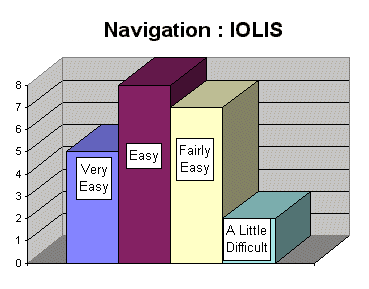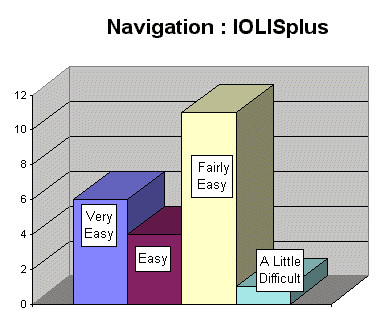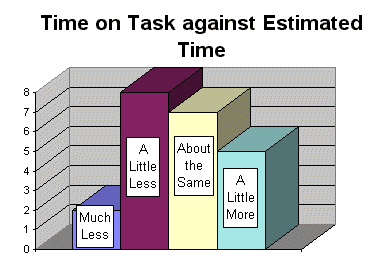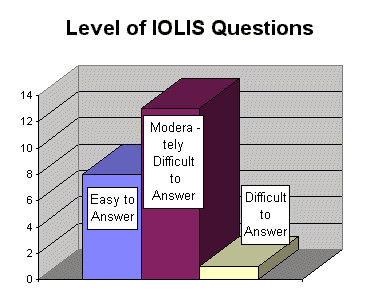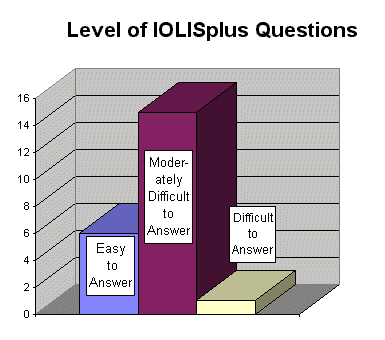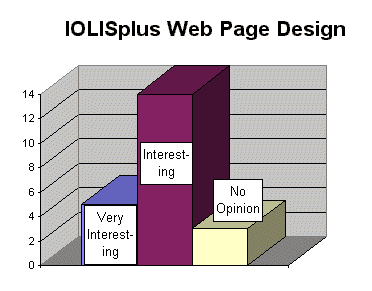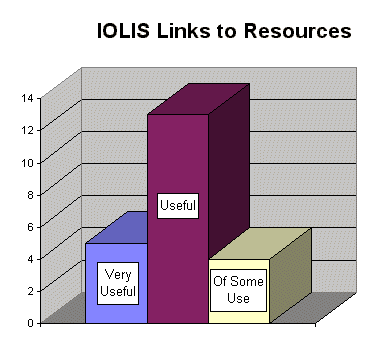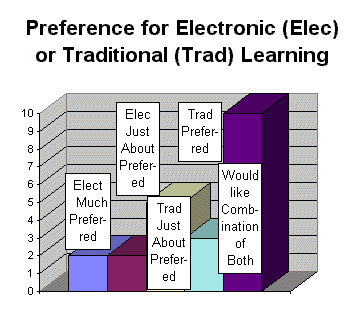JILT 2000 (1) - David Grantham
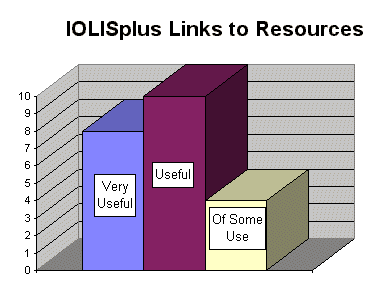
Figure 8: Results of student survey on the usefulness of IOLISplus links Because the links in IOLISplus can connect with very current and topical material it was, perhaps, no real surprise that more students found them 'very useful' when compared to IOLIS links. One student nicely summed up what a number of them had said to me about the linked material: 'The ability to be able to access relevant material/ cases at the touch of a button saves time. Additionally, it provides a no-nonsense manner in which to compare arguments'. Finally, I wanted to know whether the students preferred electronic learning to traditional learning through 'hard copy' materials, or, indeed, whether they would like a combination of both. As can be seen from the chart below, preference for traditional methods just about edged out electronic methods. However, by far the largest preference was for a combination of methods, thus supporting the contention of Naisbitt ( 1984 ) that if the introduction of new technology is going to be successful then there is also a need for a 'high human touch' component.
Figure 9: Results of student survey on preferences for electronic learning At the pilot session there was a concern over possible technical difficulties so I was present with the students at the time. I decided against asking specific questions about this pilot electronic discussion forum since responses would be distorted by the fact of my being there. There were advantages in my 'real time' attendance. I was able to motivate them and give help when needed. In particular, I had to work quite hard to get the students to make initial postings to the electronic legal forum. However, once they had made that all important first step, most of them contributed quite freely. Indeed, there were some quite unexpected postings relating to the law on psychiatric injury in New South Wales which extended everyone's knowledge , including my own. Despite this real bonus, there is clearly a need to give much more thought to how hesitant students could be motivated into making that crucial first exploratory posting. For them it is often a high-risk venture where the fear of 'getting it wrong' could be exacerbated by varying degrees of technical phobia. Students need to navigate forward confidently and in the knowledge that it's 'OK to make errors', both technical and in learning the subject matter. It is the tutor's role to lead them forward, to be alive to the need for gentle persuasion and to the timing of electronic interventions. Oakshott ( 1989 ) has highlighted the importance of what he has referred to as the 'attentiveness' of the tutor: 'If a finger can be placed on the 'human touch' of teaching, the role of attentiveness in motivating the student could well be it. As we now consider the pedagogy of online instruction, this is a key element that must be kept in the translation, at least for the great many students who need motivation from the instructor. Not only must professors provide teaching over the Internet; they must also be in contact with students to assess learning'. During the current use of IOLIS and IOLISplus I am not physically present while the student engages with the online learning environment. 'Attentiveness' on my part must therefore be demonstrated electronically. This means regular monitoring of electronic discussions in the legal forum and deploying encouraging comments. My incursions into the world of the learner are strategic, often encouraging or giving praise for perceptive postings. Examples are: Encouraging: 'You are getting close to a deeper analysis'; 'Great so far - now take a look at this case and see if it moves you closer to what you are searching for'; 'Now you are really getting somewhere - have you considered, etc. etc.' Praising: 'That's a really nice point'; 'Nice one - you really hit the nail on the head. I hadn't thought of that angle - good thinking - now can you go on and find some supporting authority for this view of the issue?' These instances may be no more than an electronic equivalent of best seminar practices. A tutor may be doing no more than would be heard in the well managed discussion. Strategic tutor interventions require both timing and a sure touch. Arguably, the best electronic discussions, like the best 'live' seminars, are those where the tutor says less and the student says more. Here, the tutor acts as mentor, guide or learned friend who enters the discussion only when he or she senses that the students need encouragement, are too far 'off task' or need a new input to take the dialogue onto a different plane. Conversely, and also like the real-time seminar, the discussion can be inhibited, or even curtailed, by insensitive or ill-considered interventions by the tutor. Wherever it is taking place, tutor comments of a sarcastic, discouraging or humiliating nature are unlikely to promote an in-depth debate. A full evaluation of the electronic legal forum will feature prominently in the next survey which will seek the views of over 140 students. One pilot student did make a specific 'free comment' on the forum, however, and I relay it here - though mainly for the pleasure I derived from reading the final part of the comment: 'I think the legal forum is a particularly good idea and would encourage me to use the system more. Also, I found IOLISplus would encourage me to use the computers more as it was friendly. Although I still prefer traditional learning I am now more willing to seek different approaches, as I am not so scared of computers now'. 4. Recent Changes to IOLISplus With Ausubel ( 1978 ) and Entwistle and Entwistle ( 1992 ) I am convinced that the most important thing the learner brings to any new learning milieu is what he or she already knows. The argument probably holds not just for topics, modules or courses but also for what students bring with them to higher education institutions generally. Each area of study within IOLISplus now begins with a list of all the prior knowledge a student should have before beginning to navigate through the less familiar waters in the new web pages. If that prior study is available in IOLISplus it will be a simple matter to hyperlink to the relevant previously charted waters. Students having doubts about their previous studies will need to revisit these before moving forward. One of the most valuable features of a web site is the area where 'Frequently Asked Questions' ('FAQ's') appear. These can quickly guide the navigator to tips and techniques, short cuts and common errors. The latter is a kind of map of the learning minefield that is undoubtedly present in many legal topics. Every IOLISplus topic area now includes 'FOM's' - 'Frequently Occurring Misunderstandings' which students can visit, via hypertext, before proceeding into mine infested waters! These are distilled from many years of seminar experience and from assessing thousands of attempts at pieces of coursework and examination scripts. Additions will no doubt be made over time. My choice of a Homer Simpson as an animated graphic for FOM's seemed appropriate since I could not imagine anyone who seems to be more frequently misunderstood! Finally, I wanted to really get myself into the role of the learner and to see, as far as I was able, how the learning seemed to feel from their perspective. Like Marton and Booth ( 1997 ) I perceived learning as a joint enterprise in which learners and teachers are the prime actors. To do this it becomes necessary to really touch base with the needs of the learners. These will, of course, vary with different learners and different topics. Some questions in IOLISplus, like questions in IOLIS, will be well within the capacity of some learners. Though I may wish it otherwise, those same questions will be outside the present capacity of other students. Of course, this inability will often be temporary and students may later return to a question with renewed confidence. In the interim, they could spend wasted time on questions that they cannot yet handle, but do not yet comprehend that they do not comprehend. To assist the process of student discernment I have made a professional judgment about each IOLISplus question in terms of its level of difficulty. Each question is weighted according to a rating scale: * Fairly easy ** More difficult *** Quite Challenging Those students who are 'strategic learners' ( Gibbs, 1981 ) will thus be empowered to follow whichever learning plan works for them. This could be to tackle all the easy questions first before moving on to the more difficult. As an alternative, they could follow a three-question combination through all levels of difficulty before moving on to another three. Those who want no more than a good pass or even a bare pass might ignore the three star questions altogether. It gives students the choice, which they can make according to their own needs and desires. Another new feature of IOLISplus is that it now resides within the framework of a WebCT electronic learning environment. From September, 1999 all Coventry University programs and modules have had their own WebCT site. This has allowed the more flexible electronic forum capacities of WebCT to be linked to IOLISplus so that fora can be set up for different seminar groups. Only those students within the group and the seminar leader can make and see postings to their forum. This helps both hesitant students and attentive tutors to move the discussions along. Other standard WebCT features are also available to students, including direct online links to the library catalogue, study skills web pages, email, group presentation areas, assessment record and student home pages. WebCT has provided yet another dimension to electronic learning since it has provided an opportunity for experimenting with yet further forms of web page design. Procedures for uploading material are rather elaborate, especially for a beginner who will need to learn 'file-zipping' to upload graphics. However, once these have been mastered there are many ways in which pages can be presented to the learner, and I am currently experimenting with different designs. Many, but not all students, are making use of a number of module WebCT sites. Although these are early days in the 'WebCT electronic world' there are favourable indicators that both students and colleagues are beginning to appreciate the power and versatility of this particular milieu. My own module site has been visited by 80% of the students registered on the module. Student tracking, an interesting if rather 'big brotherish' tool, records that the highest number of 'hits' by any one student thus far is 267. Content pages are the most frequently visited and the students make extensive use of the email facility. It is likely that the next development will be to find a way of linking IOLIS more directly with WebCT and to design pages with a facility for instant feedback after a student has made a reasonable attempt at a question. WebCT opens up other possibilities apart from the creative use of feedback mechanisms. New ways of assessing students could emerge, especially of group and individual postings to discussion fora and of work incorporated into group presentation areas. IOLISplus would be very much an integral part of any such developments and, together with WebCT could be the 'enabling technology' for the kind of collective and collaborative peer learning as advocated by Boud, Cohen and Sampson ( 1999 ), Chalmers and Volet ( 1997 ) and Slavin ( 1995 ). Designing, testing and redesigning web-based learning brings with it a new range of professional challenges. In essence, however, at its core are the old pedagogical skills of reflecting upon what tutors can do to bring about valuable learning and acting on the professional judgments emerging from this process. These decisions will include: a) designing appropriate learning experiences; b) giving the students choices so as to accommodate their different learning styles; c) giving useful and encouraging feedback; d) devising assessments that are congruent with the learning that occurs, both planned and unplanned. Electronic learning environments such as IOLISplus and WebCT and the power they give to professionals and students alike, will, to varying degrees, mean a change of role for both. But pedagogy must always lead the technology, not vice-versa. In this brave new world educators will need to master both pedagogical and technical skills and to combine both in meaningful ways to bring about better learning for their students. If lectures are simply about imparting information then electronic methods of doing this will become infinitely more effective. On the other hand, seminars or tutorials will continue to be the mainstay of a university education. Whether these are face-to-face or electronic it is where a tutor needs to be creative, innovative and versatile. For their part, students will have to accept much more of an active role in the learning process. They too will also need to master the technical skills needed to navigate around the electronic learning environment and make useful postings to discussion fora. If students willingly and positively embrace active learning in the electronic milieu then they should be better prepared than ever for the dialogue of the face-to-face environment. One of the main aims of IOLISplus and WebCT is that the web-based resources, questions and forum exchanges should better prepare students for even more complex matters to be discussed in real time seminars. IOLISplus is getting more sophisticated in its aims and objectives, more strategic in the options it affords to the learners and more complex in its pedagogy. As an electronic environment it has moved on from its original form but is still in developmental mode. This is perhaps as it should be - learning and teaching in any discipline is never the finished article. References Ausubel, D.P., Novak,J.S. and Hanesian, H. (1978) 'Educational Psychology: A Cognitive View'. Holt, Rinehart & Winston, New York. Boud, D., Cohen, R. and Sampson, J. (1999) Peer Learning and Assessment. Assessment and Evaluation in Higher Education, Volume 24, No. 4. pp413-426. Carr,W. and Kemmis, S. (1986) 'Becoming Critical' (Education Knowledge and Action Research). The Falmer Press, London. Chalmers, D. and Volet, S. (1997) Common misconceptions about students from South-East Asia in Australia. Higher Education Research and Development, 16(1) pp87-98. Davis, E. (1981) 'Teachers as evaluators. George Allen and Unwin, Sydney Entwistle, A.C. and Entwistle, N.J. (1992) ' Experiences of Understanding in Revising for Degree Examinations'. Learning and Instruction, 2, 1-22. Gibbs, G. (1981) Teaching Students to Learn; A Student Centred Approach. Open University Press, Buckingham. Grantham, D.J. (1999) IOLISplus- Extending the Electronic Learning Environment. The Journal of Information Law and technology, 1999,1, (<http://www2.warwick.ac.uk/fac/soc/law/elj/jilt/1999_1/grantham/>). Grantham, D.J. and Hunt. N (1999) ' Web Interfaces to enhance CAL materials; case studies from Law and Statistics. ALT-J Volume 7, Part 3. Guba, E.G.and Lincoln, Y.S. (1981) Effective Evaluation. Jossey Bass, San Francisco. Hara, N., and Kling, R . (1999). Students' Frustrations with a Web-based Distance Education Course: A Taboo Topic in Discourse.(< http://www.slis.indiana.edu/CSI/wp99_01.html >) Marton, F. and Booth, S. (1997) 'Learning and Awareness'. Mahwah, N.J. Lawrence Erlbaum. Marton, F and Saljo, R (1976) 'On qualitative differences in learning I: Outcome and process', British Journal of Educational Psychology, 46 4-11. Mendels, P. (1999). Study Finds Problems With Web Class. New YorkTimes. (< http://www.nytimes.com/library/tech/99/09/cyber/education/22education.html >) Naisbitt, J. (1984) 'Megatrends'. MacDonald & Co, London. Oakshott, M. (1989). Learning and Teaching. In Oakshott, M., and Fuller, T. (Eds), TheVoice of Liberal Learning. New Haven, CT: Yale University Press. Report of the National Committee of Inquiry into Higher Education 1997 (The Dearing Report). Schon, D.A. (1987) 'Educating the Reflective Practitioner'. Jossey Bass, San Francisco. Slavin, R.E. (1995) Cooperative Learning. Allyn and Bacon, Boston. |

